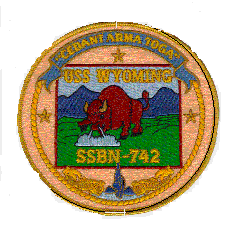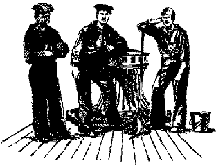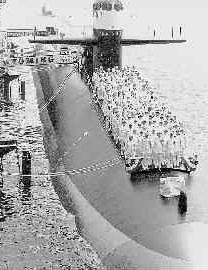 USS Wyoming, SSBN-742 to left.
USS Wyoming, SSBN-742 to left.
The present USS Wyoming is the fourth
ship (the present USS Wyoming is properly referred to as a boat, not a "ship", ships
are on top of the water, submarines are boats) in the
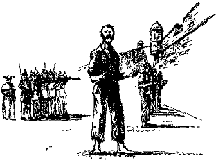 U.S. Navy named the Wyoming. For information as to the present ship click on
its website above. The first, a wooden-hulled steam sloop named after the Wyoming Valley in eastern
Pennsylvania, was launched in 1859. In 1862, under the command of Comdr. David
Stockton McDougal, the Wyoming
joined the hunt for the elusive CSS Alabama. In 1863 in a confrontation with
the Empire of Japan in the Straits of Shimonoseki, the Wyoming protected American treaty
rights in the western Pacific. U.S. Navy named the Wyoming. For information as to the present ship click on
its website above. The first, a wooden-hulled steam sloop named after the Wyoming Valley in eastern
Pennsylvania, was launched in 1859. In 1862, under the command of Comdr. David
Stockton McDougal, the Wyoming
joined the hunt for the elusive CSS Alabama. In 1863 in a confrontation with
the Empire of Japan in the Straits of Shimonoseki, the Wyoming protected American treaty
rights in the western Pacific.
In 1873, under the command of William B. Cushing,
below right, the Wyoming was dispatched with another
ship to Sandiego de Cuba as a result of the capture of the American flag
sidewheel steamer Virginius by the Spanish cruiser Tornado off Jamaica and the execution
of its captain, Joseph Fry and 53 of the crew and passengers, eight of whom were
Amerian citizens. Pen and Ink sketch of execution above right.
U.S. Steam Sloop Wyoming, lower left
William B. Cushing, lower right.
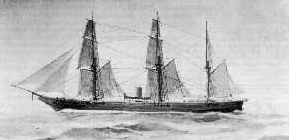
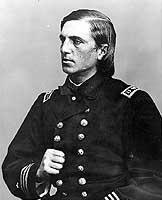 The Appearance of the Wyoming resulted in the release of the remaining 51 sailors and the return of
the Virginius to its owners. The Virginius Affair resulted in realization of the necessity of
upgrading the Navy and distrust of the Spanish in Cuba which, in turn, had an impact 25 years
later on public perception of blame for the sinking the the Maine. It was later discovered
that, in fact, the Virginius was owned by Cubans and was not entitled to American flag status.
On 30 October 1882 the Wyoming was decommissioned. On 9 May 1892 she was sold.
The Appearance of the Wyoming resulted in the release of the remaining 51 sailors and the return of
the Virginius to its owners. The Virginius Affair resulted in realization of the necessity of
upgrading the Navy and distrust of the Spanish in Cuba which, in turn, had an impact 25 years
later on public perception of blame for the sinking the the Maine. It was later discovered
that, in fact, the Virginius was owned by Cubans and was not entitled to American flag status.
On 30 October 1882 the Wyoming was decommissioned. On 9 May 1892 she was sold.
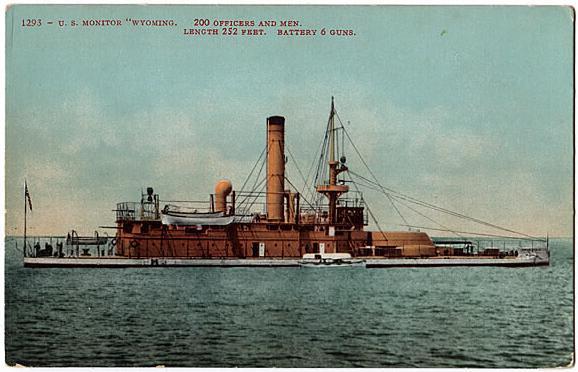 The second USS Wyoming was the
United States Monitor Wyoming, pictured to the left, was authorized in 1898,
launched in 1900, at the Union Iron Works in San Francisco. Her sponsor
was Miss Hattie Warren, daughter of Wyoming U.S. Senator Francis E. Warren. In 1908 she
became the first U.S. ship to be converted from coal to oil. The front turret was added
approximately the same year (compare photos below with earlier photo to left). Her name was
changed to the USS Cheyenne on 1 January 1909, in order to permit a third vessel to be named
the USS Wyoming. In 1913, she was refitted as a submarine tender. The Cheyenne was decommissioned in 1920, recommissioned and
decommissioned for the final time on 1 June 1926, struck from the Navy list on
25 Jan 1937 and sold for scrap on 20 April 1939. Photo of the Cheyenne
in dry dock below. The second USS Wyoming was the
United States Monitor Wyoming, pictured to the left, was authorized in 1898,
launched in 1900, at the Union Iron Works in San Francisco. Her sponsor
was Miss Hattie Warren, daughter of Wyoming U.S. Senator Francis E. Warren. In 1908 she
became the first U.S. ship to be converted from coal to oil. The front turret was added
approximately the same year (compare photos below with earlier photo to left). Her name was
changed to the USS Cheyenne on 1 January 1909, in order to permit a third vessel to be named
the USS Wyoming. In 1913, she was refitted as a submarine tender. The Cheyenne was decommissioned in 1920, recommissioned and
decommissioned for the final time on 1 June 1926, struck from the Navy list on
25 Jan 1937 and sold for scrap on 20 April 1939. Photo of the Cheyenne
in dry dock below.
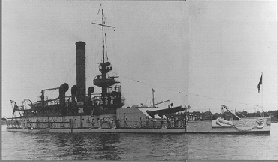
USS Cheyenne,
formerly the Wyoming |
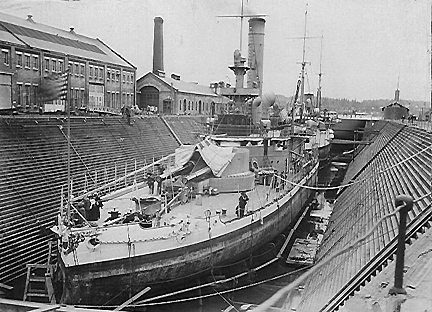
USS Cheyenne,
formerly, the Wyoming |
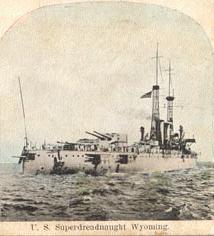
Dreadnaught USS Wyoming |
The third USS Wyoming, pictured left and below, commissioned on 25 September 1912 and became
the flagship of the Commander of the United States Atlantic Fleet. She had a length of
562 feet, beam of 93 ft. draft of 28 ft. 6 in. and with its 28,000 hp. turbin engines could
make a top speed of 21 knots. It saw duty during both world wars and was a part
of the Sixth Battle Squadron of the "Grand Fleet" following the Unites States' entry into World War I. In
1931, as a result of the London treaty limiting naval armaments, her armor was removed together
with the guns and turret machinery from three of its six main battery turrets. During WW II she was
converted to a gunnery training ship, training some 35,000 Sailors on seven different
types of guns. Among those
serving on her prior to her decommissioning in 1947 was later Fleet Admiral William Frederick Halsey, Jr.,
who served as Executive Officer and Lt. James Earle Carter, Jr., later President of the United States, who, following graduation from
the Acadamy, served as Radar Officer. |
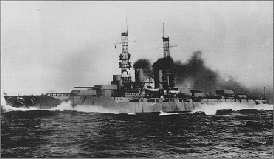
Battleship USS Wyoming, underway |

USS Wyoming
The present USS Wyoming, pictured at the top of the page, may not, however,
be the last. The television program Star Trek has predicted the existence of a USS Wyoming in space,
just as Capt. Cook's HMS Endeavour finds its counterpart in the space shuttle program. Pictured below
is the Mediterranean Class Starship of which the Starship USS Wyoming mentioned in the episode
Flashback, will be a part in the 24th Century.

United Federation of Planets USS Wyoming, NCC-43730 |
ETERNAL FATHER, STRONG TO SAVE
(The Navy Hymn)
Eternal Father, strong to save,
Whose arm hath bound the restless wave,
Who bidd'st the mighty ocean deep
Its own appointed limits keep;
Oh, hear us when we cry to Thee,
For those in peril on the sea!
O Christ! Whose voice the water heard
And hushed their raging at Thy word,
Who walked'st on the foaming deep,
And calm amidst its rage didst sleep;
Oh, hear us when we cry to Thee,
For those in peril on the sea!
Most Holy Spirit! Who didst brood
Upon the chaos dark and rude,
And bid its angry turmult cease,
And give, for wild confusion, peace;
Oh, hear us when we cry to Thee,
For those in peril on the sea!
O Trinity of love and power!
Our brethren shield in danger's hour;
From rock and tempest, fire and foe,
Protect them wheresoe'er they go;
Thus evermore shall rise to Thee
Glad hymns of praise from land and sea.
 This page suggested by Brother Elk, Mike L.,
This page suggested by Brother Elk, Mike L.,
father of a former member of the Boat's Company, USS Wyoming.
Bro. Mike for some unknown reason always wears green.
|
